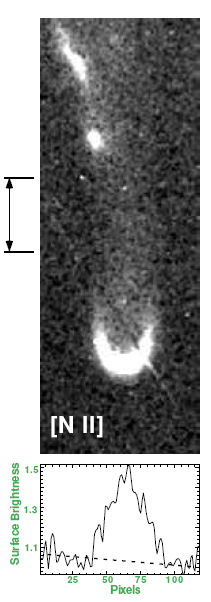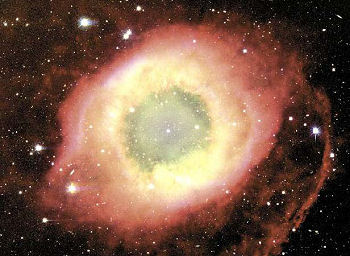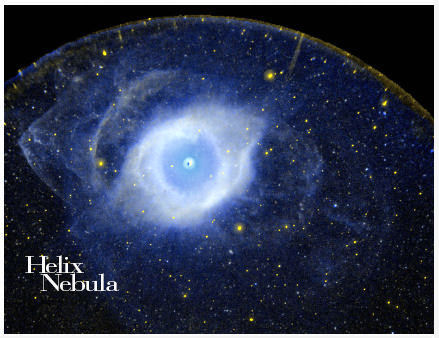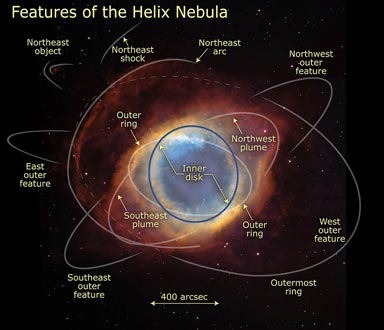 Image: Public Domain Clip Art: Helix Nebula
Image: Public Domain Clip Art: Helix Nebula
"
Now, a team of astronomers using observations from several observatories, including NASA's Hubble Space Telescope, has established that the Helix's structure is even more perplexing. Their evidence suggests that the Helix consists of two gaseous disks nearly perpendicular to each other." [14]
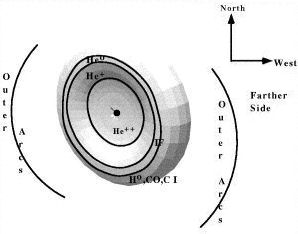
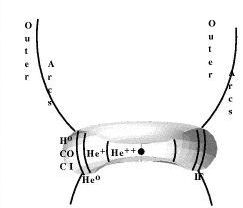 This
This three-dimensional model of the Helix Nebula illustrates, at left, the object as viewed in the plane of the sky, while the right image shows a cross section through the symmetry axis. "The relative width of the neutral hydrogen zone is unknown. Although drawn as open forms, the upper and lower structures above and below the main disk may be closed bubbles, either model being consistent with the observed outer arcs."
"
Ordinary images of the helix give an immediate impression that there is an empty central core, a feature of all of the three-dimensional models of the nebula [see above]. However, the H image shown in Figure 1 [see below] argues that this is not the case, and the He II image establishes that this region has substantial material." [15]
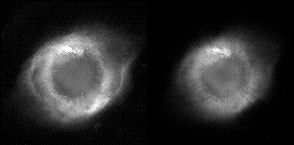
Appearance of the helix in various bands
I) Left is the calibrated H image, and the right is the corresponding [O III] 5007 Å image.
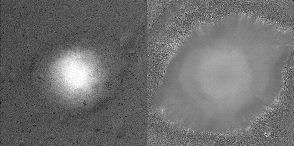
Appearance of the helix in various bands
II) The image on left is the 4697 filter image, which isolates the He II line at 4686 Å with the right image being 5007 Å divided by H emission. All of these images have had their stars edited out to show the emission only, and their field of view is 1180" × 1180".
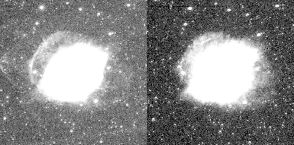
Appearance of the helix in various bands
III) These two images show the combined H (left) and 5007 Å images prior to editing out the stars and printed to show the fainter outer regions. The difference in the structure is discussed in the text. The field of these two images is 2360" × 2360". [Ibid, fig.1]
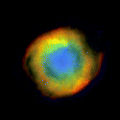
Color-coded image of the Helix Nebula illustrates the ionization stratification of this nebula. Red is used for emission in H, green for [O III], and blue for He II. The stars in the field have been edited out by interpolation from the adjacent pixels. The orientation is north up and west right. The field of view is 1180 × 1180. The zones defined in the text are well illustrated, with the He+2 zone appearing as blue, the He+ as yellow, and the He0 zone as red.
The Astronomical Journal, 116:1346-1356, 1998 September




 Appearance of the helix in various bands I) Left is the calibrated H image, and the right is the corresponding [O III] 5007 Å image.
Appearance of the helix in various bands I) Left is the calibrated H image, and the right is the corresponding [O III] 5007 Å image. Appearance of the helix in various bands II) The image on left is the 4697 filter image, which isolates the He II line at 4686 Å with the right image being 5007 Å divided by H emission. All of these images have had their stars edited out to show the emission only, and their field of view is 1180" × 1180".
Appearance of the helix in various bands II) The image on left is the 4697 filter image, which isolates the He II line at 4686 Å with the right image being 5007 Å divided by H emission. All of these images have had their stars edited out to show the emission only, and their field of view is 1180" × 1180". Appearance of the helix in various bands III) These two images show the combined H (left) and 5007 Å images prior to editing out the stars and printed to show the fainter outer regions. The difference in the structure is discussed in the text. The field of these two images is 2360" × 2360". [Ibid, fig.1]
Appearance of the helix in various bands III) These two images show the combined H (left) and 5007 Å images prior to editing out the stars and printed to show the fainter outer regions. The difference in the structure is discussed in the text. The field of these two images is 2360" × 2360". [Ibid, fig.1] Color-coded image of the Helix Nebula illustrates the ionization stratification of this nebula. Red is used for emission in H, green for [O III], and blue for He II. The stars in the field have been edited out by interpolation from the adjacent pixels. The orientation is north up and west right. The field of view is 1180 × 1180. The zones defined in the text are well illustrated, with the He+2 zone appearing as blue, the He+ as yellow, and the He0 zone as red.
Color-coded image of the Helix Nebula illustrates the ionization stratification of this nebula. Red is used for emission in H, green for [O III], and blue for He II. The stars in the field have been edited out by interpolation from the adjacent pixels. The orientation is north up and west right. The field of view is 1180 × 1180. The zones defined in the text are well illustrated, with the He+2 zone appearing as blue, the He+ as yellow, and the He0 zone as red. 
